8-orthoplex
| 8-orthoplex Octacross | |
|---|---|
 Orthogonal projection inside Petrie polygon | |
| Type | Regular 8-polytope |
| Family | orthoplex |
| Schläfli symbol | {36,4} {3,3,3,3,3,31,1} |
| Coxeter-Dynkin diagrams | |
| 7-faces | 256 {36} |
| 6-faces | 1024 {35} |
| 5-faces | 1792 {34} |
| 4-faces | 1792 {33} |
| Cells | 1120 {3,3} |
| Faces | 448 {3} |
| Edges | 112 |
| Vertices | 16 |
| Vertex figure | 7-orthoplex |
| Petrie polygon | hexadecagon |
| Coxeter groups | C8, [36,4] D8, [35,1,1] |
| Dual | 8-cube |
| Properties | convex |
In geometry, an 8-orthoplex or 8-cross polytope is a regular 8-polytope with 16 vertices, 112 edges, 448 triangle faces, 1120 tetrahedron cells, 1792 5-cells 4-faces, 1792 5-faces, 1024 6-faces, and 256 7-faces.
It has two constructive forms, the first being regular with Schläfli symbol {36,4}, and the second with alternately labeled (checkerboarded) facets, with Schläfli symbol {3,3,3,3,3,31,1} or Coxeter symbol 511.
It is a part of an infinite family of polytopes, called cross-polytopes or orthoplexes. The dual polytope is an 8-hypercube, or octeract.
Alternate names
- Octacross, derived from combining the family name cross polytope with oct for eight (dimensions) in Greek
- Diacosipentacontahexazetton as a 256-facetted 8-polytope (polyzetton)
As a configuration
The elements of the regular polytopes can be expressed in a configuration matrix. Rows and columns reference vertices, edges, faces, and cells, with diagonal element their counts (f-vectors). The nondiagonal elements represent the number of row elements are incident to the column element. The configurations for dual polytopes can be seen by rotating the matrix elements by 180 degrees.[1][2]
The diagonal f-vector numbers are derived through the Wythoff construction, dividing the full group order of a subgroup order by removing individual mirrors. [3]
| B8 | k-face | fk | f0 | f1 | f2 | f3 | f4 | f5 | f6 | f7 | k-figure | notes | |
|---|---|---|---|---|---|---|---|---|---|---|---|---|---|
| B7 | ( ) | f0 | 16 | 14 | 84 | 280 | 560 | 672 | 448 | 128 | {3,3,3,3,3,4} | B8/B7 = 2^8*8!/2^7/7! = 16 | |
| A1B6 | { } | f1 | 2 | 112 | 12 | 60 | 160 | 240 | 192 | 64 | {3,3,3,3,4} | B8/A1B6 = 2^8*8!/2/2^6/6! = 112 | |
| A2B5 | {3} | f2 | 3 | 3 | 448 | 10 | 40 | 80 | 80 | 32 | {3,3,3,4} | B8/A2B5 = 2^8*8!/3!/2^5/5! = 448 | |
| A3B4 | {3,3} | f3 | 4 | 6 | 4 | 1120 | 8 | 24 | 32 | 16 | {3,3,4} | B8/A3B4 = 2^8*8!/4!/2^4/4! = 1120 | |
| A4B3 | {3,3,3} | f4 | 5 | 10 | 10 | 5 | 1792 | 6 | 12 | 8 | {3,4} | B8/A4B3 = 2^8*8!/5!/8/3! = 1792 | |
| A5B2 | {3,3,3,3} | f5 | 6 | 15 | 20 | 15 | 6 | 1792 | 4 | 4 | {4} | B8/A5B2 = 2^8*8!/6!/4/2 = 1792 | |
| A6A1 | {3,3,3,3,3} | f6 | 7 | 21 | 35 | 35 | 21 | 7 | 1024 | 2 | { } | B8/A6A1 = 2^8*8!/7!/2 = 1024 | |
| A7 | {3,3,3,3,3,3} | f7 | 8 | 28 | 56 | 70 | 56 | 28 | 8 | 256 | ( ) | B8/A7 = 2^8*8!/8! = 256 |
Construction
There are two Coxeter groups associated with the 8-cube, one regular, dual of the octeract with the C8 or [4,3,3,3,3,3,3] symmetry group, and a half symmetry with two copies of 7-simplex facets, alternating, with the D8 or [35,1,1] symmetry group.A lowest symmetry construction is based on a dual of an 8-orthotope, called an 8-fusil.
| Name | Coxeter diagram | Schläfli symbol | Symmetry | Order | Vertex figure |
|---|---|---|---|---|---|
| regular 8-orthoplex | {3,3,3,3,3,3,4} | [3,3,3,3,3,3,4] | 10321920 | ||
| Quasiregular 8-orthoplex | {3,3,3,3,3,31,1} | [3,3,3,3,3,31,1] | 5160960 | ||
| 8-fusil | 8{} | [27] | 256 |
Cartesian coordinates
Cartesian coordinates for the vertices of an 8-cube, centered at the origin are
- (±1,0,0,0,0,0,0,0), (0,±1,0,0,0,0,0,0), (0,0,±1,0,0,0,0,0), (0,0,0,±1,0,0,0,0),
- (0,0,0,0,±1,0,0,0), (0,0,0,0,0,±1,0,0), (0,0,0,0,0,0,0,±1), (0,0,0,0,0,0,0,±1)
Every vertex pair is connected by an edge, except opposites.
Images
| B8 | B7 | ||||
|---|---|---|---|---|---|
 |
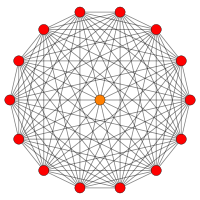 | ||||
| [16] | [14] | ||||
| B6 | B5 | ||||
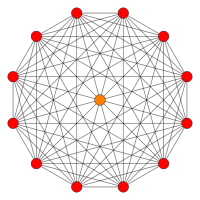 |
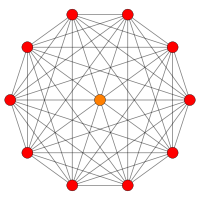 | ||||
| [12] | [10] | ||||
| B4 | B3 | B2 | |||
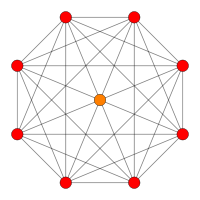 |
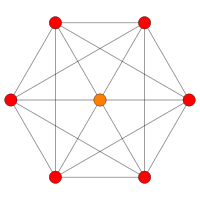 |
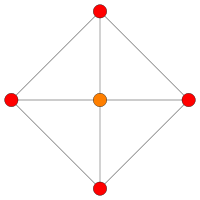 | |||
| [8] | [6] | [4] | |||
| A7 | A5 | A3 | |||
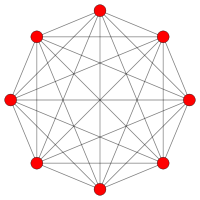 |
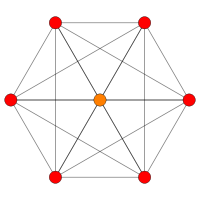 |
 | |||
| [8] | [6] | [4] | |||
It is used in its alternated form 511 with the 8-simplex to form the 521 honeycomb.
References
- ↑ Coxeter, Regular Polytopes, sec 1.8 Configurations
- ↑ Coxeter, Complex Regular Polytopes, p.117
- ↑ Klitzing, Richard. "x3o3o3o3o3o3o4o - ek".
- H.S.M. Coxeter:
- H.S.M. Coxeter, Regular Polytopes, 3rd Edition, Dover New York, 1973
- Kaleidoscopes: Selected Writings of H.S.M. Coxeter, edited by F. Arthur Sherk, Peter McMullen, Anthony C. Thompson, Asia Ivic Weiss, Wiley-Interscience Publication, 1995,
ISBN 978-0-471-01003-6
- (Paper 22) H.S.M. Coxeter, Regular and Semi Regular Polytopes I, [Math. Zeit. 46 (1940) 380-407, MR 2,10]
- (Paper 23) H.S.M. Coxeter, Regular and Semi-Regular Polytopes II, [Math. Zeit. 188 (1985) 559-591]
- (Paper 24) H.S.M. Coxeter, Regular and Semi-Regular Polytopes III, [Math. Zeit. 200 (1988) 3-45]
- Norman Johnson Uniform Polytopes, Manuscript (1991)
- N.W. Johnson: The Theory of Uniform Polytopes and Honeycombs, Ph.D.
- Klitzing, Richard. "8D uniform polytopes (polyzetta) x3o3o3o3o3o3o4o - ek".
External links
- Olshevsky, George. "Cross polytope". Glossary for Hyperspace. Archived from the original on 4 February 2007.
- Polytopes of Various Dimensions
- Multi-dimensional Glossary
Fundamental convex regular and uniform polytopes in dimensions 2–10 | ||||||||||||
|---|---|---|---|---|---|---|---|---|---|---|---|---|
| Family | An | Bn | I2(p) / Dn | E6 / E7 / E8 / F4 / G2 | Hn | |||||||
| Regular polygon | Triangle | Square | p-gon | Hexagon | Pentagon | |||||||
| Uniform polyhedron | Tetrahedron | Octahedron • Cube | Demicube | Dodecahedron • Icosahedron | ||||||||
| Uniform 4-polytope | 5-cell | 16-cell • Tesseract | Demitesseract | 24-cell | 120-cell • 600-cell | |||||||
| Uniform 5-polytope | 5-simplex | 5-orthoplex • 5-cube | 5-demicube | |||||||||
| Uniform 6-polytope | 6-simplex | 6-orthoplex • 6-cube | 6-demicube | 122 • 221 | ||||||||
| Uniform 7-polytope | 7-simplex | 7-orthoplex • 7-cube | 7-demicube | 132 • 231 • 321 | ||||||||
| Uniform 8-polytope | 8-simplex | 8-orthoplex • 8-cube | 8-demicube | 142 • 241 • 421 | ||||||||
| Uniform 9-polytope | 9-simplex | 9-orthoplex • 9-cube | 9-demicube | |||||||||
| Uniform 10-polytope | 10-simplex | 10-orthoplex • 10-cube | 10-demicube | |||||||||
| Uniform n-polytope | n-simplex | n-orthoplex • n-cube | n-demicube | 1k2 • 2k1 • k21 | n-pentagonal polytope | |||||||
| Topics: Polytope families • Regular polytope • List of regular polytopes and compounds | ||||||||||||